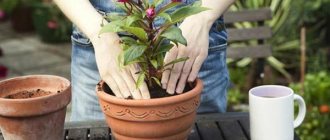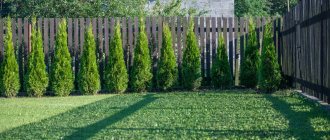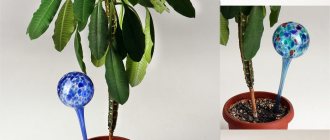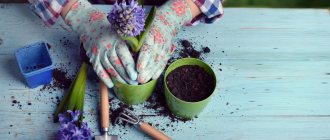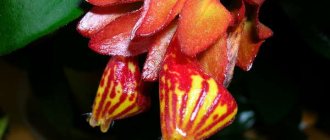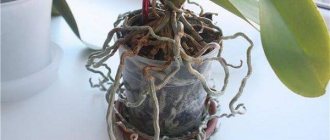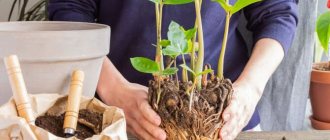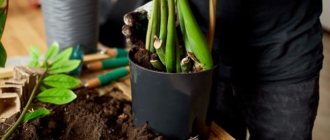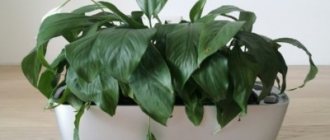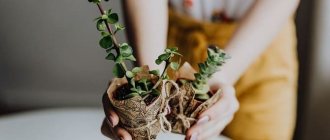- December 31, 2019
- Country house
- Maria Tatarova
There are indoor plants in almost every apartment. They are part of the interior and create a cozy atmosphere. But in addition to aesthetic pleasure, plants also perform a very important function for humans: they participate in the formation of oxygen, without which humans simply cannot live. Houseplants, unlike their “relatives” living in nature, are in an artificial environment and therefore require special care. One of its important components is plant transplantation. A serious question is which day is best to replant indoor flowers.
Types and methods of transplantation
There are two types of transplantation: planned and emergency. When planning, it is decided in advance which days it is better to replant indoor flowers. An emergency transplant is necessary if the pot is damaged or the flower is suddenly affected by any disease. But still, turning to replanting as a way to cure a plant should be done only as a last resort, when other means have not helped. The fact is that replanting flowers is stressful. Therefore, it is so important to understand on which days you can replant indoor plants and on which days you cannot.
There are three ways to transplant indoor flowers.
- Full. The soil changes completely, every root is shaken off the ground. The most stressful method of transplantation for a plant.
- Incomplete. The roots are placed in a new pot along with a lump of earth adjacent to the roots.
- Replacement of topsoil. The soil is loosened, the top layer is poured out and new soil is added. The most gentle way for the flower.
How does this happen
Those dates of the lunar calendar that are indicated as favorable days for replanting indoor plants coincide with the period when the juice moves to the stem and leaves, that is, to the top of the flower. At the same time, the root system experiences a decrease in turgor and slight dehydration of cells, as a result of which they become less fragile.
The above coincides with the waxing phase of the moon. When it decreases, the opposite happens - the roots are filled with moisture. They should not be disturbed at this time. Thus, it is much easier to achieve a blooming and healthy appearance of an indoor garden by consulting the recommendations of the lunar calendar.
When is a transplant required?
You should not replant the plant thoughtlessly. This can lead to the fact that it simply cannot withstand the load and dies. But the same fate may await it if it is not replanted at all. In this matter, it is important to know when it is time to transplant flowers. Young indoor plants that are no more than 3-4 years old need to be replanted every year. The reason is that the root system of the flower grows and it needs more and more space. If there is not enough space, the color will simply fade. Plants older than 3-4 years do not need to be replanted every year. This is extra stress for them. This should be done when necessary, according to certain signs.
How to understand that a flower needs replanting?
- The plant has grown, and it is clear that the roots are cramped in this pot.
- The plant begins to fade, lose strength and beauty. The leaves droop, turn yellow, the plant does not bloom or blooms poorly. Perhaps the soil has become depleted. The minerals needed by the flower have become scarce, so the substrate needs to be updated.
It is important not to forget to periodically feed the flower.
Choosing seedlings
There is nothing complicated in this matter, but I still advise you to pay attention to a few nuances:
Root system
From practice it follows that it is more advisable to buy seedlings with a closed root system (in peat or small plastic pots). It is advisable that there is one plant in each container (unless you are planning bouquet plantings in flower beds). It is very important that the roots are not overgrown or oppressed: if they do not have enough space for natural growth and they are intertwined in a ball, such a plant will be of little use. This is why many gardeners are afraid to purchase seedlings in cassettes with a minimum cell volume.
Diseases and pests
Do not hesitate to carefully examine each plant you purchase for the presence of diseases and pests, and feel the moisture content of the substrate in the container with your finger (it should under no circumstances be dry!). Stems and leaves must be fresh, strong, natural color for this species and variety, without spots, plaque or damage. Do not take specimens with unnaturally bright leaf colors and unusually thick stems and short internodes. It is obvious that a huge amount of fertilizers and stimulants were used in their cultivation. After planting in a flowerbed, without receiving the usual diet, such a plant will quickly lose its spectacular appearance and will probably die.
Seedlings must be hardened
No options. If plants that have been pampered indoors end up directly in a sunny flower bed, they are unlikely to survive such stress. There is one amazingly simple and sure way to determine whether seedlings took part in hardening events or arrived on the counter straight from the greenhouse.
Seedlings must be hardened, otherwise problems will arise after planting in open ground
Remember what the newly blossoming leaves on the trees look like in the spring. They are soft green in color, almost transparent, with a shiny smooth leaf surface. And if we look at them after two weeks, we will see that the color of the leaf has darkened, the surface has lost its varnish shine and has become rougher. These are signs of outdoor life - the result of exposure to sun, wind and changing day and night temperatures. So look for these signs in the seedlings!
Consider the characteristics of plants
What time of year to replant?
On what days can you replant indoor flowers? First, let's decide on the time of year.
The best time is spring. At this time, all nature wakes up, comes to life, and gains strength. In spring, it will be easier for flowers to tolerate such significant changes in their living environment. And besides, it is in the spring that plants need more minerals. Flowers at this time enter an active phase of life: they grow, prepare for an important period - flowering. Most plants bloom in summer. This takes all the energy, so replanting at this time of year is undesirable. On what days should I replant indoor flowers in the fall? Better - in September. The plant has finished flowering, but has not yet gone into hibernation. If indoor flowers were transplanted into the garden for the summer, then in September it’s time to return them back to the pots. Starting in late autumn and throughout the winter, the houseplant should not be disturbed. The phase of calm or sleep begins. All processes in the plant slow down, so it may not survive transplantation. And even an emergency transplant should be postponed if possible. For example, if the pot did not break, but cracked, then you can wait to replant.
Preparing seeds, containers and soil for sowing
Before you start sowing seeds, you need to tidy up the container for the soil, the soil itself and prepare the seeds themselves. To begin with, all selected containers for seedlings need to be holed, that is, a drainage system must be made - several holes must be pierced at the bottom of the containers through which excess moisture will flow out. If you are too lazy to do this, then you can buy ready-made pots for seedlings, of which a huge number are sold in stores. Then all jars and boxes should be thoroughly washed with soap and water, and then with soda solution.
On a note! It would be good if a layer of expanded clay was placed at the bottom of each jar or box as a drainage material.
Soil for seedlings must undergo a disinfection procedure. It can be steamed, calcined or spilled with a pink solution of potassium permanganate. After this, it is important to dry the soil well.
Flower seeds should be prepared for planting - disinfected. They are soaked for 12 hours in a weak solution of potassium permanganate. This will protect the seed from various diseases. You can also carry out a stratification procedure - it will help speed up the process of the appearance of the first shoots. To do this, the seeds are soaked for 12 hours in clean water, and then the container with them should be put in the refrigerator for the same time. After this, they are returned to the warm room again, and then back to the refrigerator. The procedure is carried out until the seeds begin to germinate.
On a note! This procedure will improve the plants' resistance to low air temperatures.
What time of day
When choosing on what day to transplant flowers into different soil, it is important to focus on both the time of day and the weather. As experienced gardeners advise, it is better that the weather is cloudy and warm, but not hot. Heat is unfavorable for the plant, as is cold, so warm and cloudy weather is just right. It is better to do this from 16:00 to 19:00. In the morning the plant has not yet woken up, and in the afternoon it is already hot, so you should not disturb it at this time.
Heat
Newly planted starter plants and seedlings always experience transplant shock. Leaves may wilt or fall off for some time after planting. Hot direct sunlight can cause irreparable damage to freshly harvested seedlings. It is best to choose a quiet time of day when the plant has more time to recover before encountering full sunlight. Late evening is especially beneficial in hot weather, as hours of hot sun immediately after planting can aggravate mild wilt caused by transplant shock. Water the plant and let it sit overnight to give it time to absorb the water before the sun rises in the morning.
According to the lunar calendar
Scientists have proven that the Moon influences the movement of water on Earth. And not only on the ebb and flow of tides, but also on the movement of fluid in organisms, including sap in plants. Therefore, a good gardener, when determining on what day to replant flowers in a different soil, will also pay attention to the phase of the moon. Why does the movement of sap in a flower affect transplantation? The fact is that it is impossible to replant a plant without damaging the roots. Therefore, it is better that during replanting the juice is in the above-ground part of the plant, and not in the roots. This occurs on the full moon, which takes three days (the day of the full moon itself and one day before and after it). During the full moon, the largest accumulation of sap occurs in the above-ground part of the plant, making this the most optimal time for replanting. A less suitable phase, but still acceptable, is the waxing Moon. At this time, the liquid is still moving from the roots to the top. The phases of the waning moon and the new moon are the most unfavorable. During the waning moon, the sap is directed to the roots, and on the new moon, all nutrition is concentrated in the roots. If you damage them during this period, the plant may die.
Planting seeds
Now let's take a look at the step-by-step instructions for sowing flower seeds. There is nothing complicated here.
Step 1: Let's start with primrose seeds as one of the most commonly grown flowering plants. We fill the containers prepared for seedlings with drainage material and treated soil, and lightly tamp them. After this, moisten it a little with a spray bottle.
Step 2. Open the bag of seeds and carefully take them on your finger (be careful - they are very small) and carefully, as if salting food, sprinkle them on the soil.
Step 3. We once again slightly moisten the soil together with the seeds with water from a spray bottle.
Step 4. Cover the container with a lid or polyethylene. Don’t forget to write the name of the variety or type of flower on the container. Place the container in the refrigerator on the bottom shelf for stratification for 3 weeks.
After stratification, primrose seeds must be placed immediately on a sunny window. The technology for sowing lavender seeds looks somewhat different.
Step 1. Take a couple of pieces of soft fabric, fold one of them in half and moisten it with water from a spray bottle.
Step 2. Open the package with lavender seeds and pour them onto a damp cloth. Wrap it up and put it in a plastic bag with a clip.
Step 3. After this, put the seed bags in the refrigerator on the bottom shelf for 3 weeks. After this, we sow the seeds superficially on moist soil, as in the previous instructions.
The first shoots will appear in a couple of weeks. After this, the seedlings will need careful care - good lighting, watering, warmth.
Planting tomato seeds for seedlings
Of course, you can buy ready-made tomato seedlings in the store, but it will be much more pleasant to grow them yourself. The first step on the path to growing seedlings will be planting tomato seeds for seedlings. For many, this process may seem simple, but it is much more complicated than it may seem.
It should be located on a well-lit windowsill, where it will also receive enough heat - drafts are unacceptable. It is necessary to moisten the soil as it dries. Young plants are watered from a spray bottle, larger ones that have undergone the picking procedure are fed and watered from a watering can with a spout. By the way, it is best to water with water that is not only settled, but also at room temperature.
Which pot to choose
In addition to deciding on what day to transplant flowers into another container, the choice of pot also matters. Which is better - plastic or ceramic? Each has its own pros and cons. It is difficult for air to circulate through the walls of a plastic pot, so the oxygen necessary for growth is poorly supplied to the roots. But the moisture lasts longer. Accordingly, in a ceramic pot without glaze coating, air circulates through the walls more easily, but moisture also evaporates faster. Of course, pots also differ in weight: ceramic ones are much heavier than plastic ones. It is best to choose a pot based on the characteristics of the flower for which it is intended. For example, a plastic pot is suitable for ferns and palm trees that love moisture, and a ceramic pot is suitable for cactus plants. You must also remember that there should be holes at the bottom of the pot to create breathability.
What soil to use
There are two options here: buy a ready-made substrate or prepare it yourself. The first option is the simplest. But there is a minus here. Each plant prefers its own soil composition. For example, some plants need more sand, others need peat, and others need turf. Ready-made soil sold in stores usually contains an average composition of components and may not be suitable for some plants. It is best to prepare the substrate separately for each flower in accordance with its preferences. This will create favorable conditions for growth and development.
General sowing rules
Any plant has its own requirements for growing conditions, but there are some general rules that unite the procedures for sowing seeds of any flowers. Most experienced gardeners, of course, are familiar with these nuances, but a beginner will be interested to learn about them.
First, you should take care of the equipment that may be needed for a successful procedure. These are all kinds of containers for sowing seeds and picking seedlings. In order not to spend extra money, which, as we know, does not happen, you can take care of the containers in advance and have time to collect a lot of jars of food and drinks. These containers may well make good containers for flowers.
To water the soil with sown seeds, it is better to purchase a spray bottle - it will not wash out the soil or disturb the flower seeds, which are usually very small. Grown seedlings can also be watered with a watering can with a thin spout.
On a note! Before you sow your seeds, make sure you have labels with the names of the varieties you will be growing.
Sequence of actions during transplantation
- Determine in advance on what day you can replant flowers in a different soil.
- Prepare the soil and pot. Both the new and the already used pot must be soaked in boiling water for a while, washed and dried. This is necessary in order to kill all pathogenic bacteria. This is especially important if the flower that grew in this pot was sick.
- The flower must be watered abundantly within 24 hours so that the soil fits tightly to the roots and they are damaged as little as possible during replanting.
- Sprinkle drainage on the bottom of the pot. To do this, you can use broken brick or ceramics, shards, pebbles, crushed stone or gravel. Drainage creates air circulation, prevents the soil from compacting and becoming rocky, and helps water to be evenly distributed so that pockets of high humidity do not form, which can sour and lead to rotting of the roots.
- Add some soil to the pot.
- Turn the pot with the plant upside down, carefully turning the container and dragging it up. If the soil adheres tightly to the walls, you can insert a spatula to help the soil separate.
- Further actions depend on the method of transplantation. If it is incomplete, the earthen lump is lightly shaken off and placed in the center of a new pot. When replanting completely, the roots must be completely cleared of soil. This must be done carefully, trying to damage them as little as possible. After which you need to carefully examine the roots. If they are rotten or dry, the roots need to be cut back to the point where the rot or dryness ends. And then the plant is also placed in the center of the pot.
- The plant should be placed in the pot approximately 2 centimeters below the rim of the container. After this, you need to fill the remaining free space in the pot with soil, compacting the soil with your fingers.
- The flower needs to be watered. And sprinkle dry soil on top. If during the replanting process many roots were damaged or removed, you should not water the plant.
How to plant seedlings of annual flowers in the ground - useful tips
When the ground finally thaws and warms up, work begins on the garden plot.
We sow flowers in the soil and plant seedlings so that within a couple of months we can see beautiful and graceful flower beds.
Typically, annual crops are grown through seedlings.
Let's talk in more detail about how to plant annuals in open ground.
When to plant annual seedlings on the plot?
To successfully plant seedlings of annual crops in open ground, it is necessary to take into account the time of planting, hardening, fertilizing and care.
Annuals have different resistance to cold, this is what determines the time of planting annual crops.
In the conditions of central Russia, it is recommended to send seedlings of the following annual plants to open ground before May 15:
Lobelia, lobularia and dwarf snapdragons are planted at intervals of 150 mm between seedlings, cabbage at intervals of 300–350 mm, and other annuals at intervals of 200–250 mm.
Hardened annuals cope well with returns of night frosts down to minus 4 °C, scabiosis - up to minus 2 °C.
However, if there is a threat of a drop in temperature, it is better to cover the seedlings with a special cloth before nighttime.
After May 20, experts advise planting seedlings of the following annuals:
These plants should be planted at intervals of 300–400 mm.
These annuals, if hardened, will be able to withstand short-term frosts down to minus 2 C.
Hardening off annual flower seedlings
All seedlings grown at home need hardening in advance.
Otherwise, when exposed to the sun, tender seedlings will receive severe burns and may die.
It takes 2 weeks to harden the seedlings; during this period they should be taken out to a balcony, open flowerbed or garden plot.
First, the seedlings should be left in the sun for a couple of hours in the morning, and for the rest of the period, the seedlings should be covered with a special cloth or shaded in another way.
Over time, the period of exposure to sunlight should be increased, and at the end of hardening the plants, the seedlings should be left in the garden area for a full 24 hours.
When hardening, it is important to protect annuals from the effects of wind.
If there is a threat of a sharp drop in temperature, the seedlings must be brought home into a warm place or they will die.
Planting and fertilizing flower seedlings
Experts recommend paying attention to the correct choice of location, soil preparation, planting techniques and after-planting care for flower crops.
Almost all annuals grow happily in full sun.
The soil should not be very oily or too poor.
If organic matter and lime have not been used as fertilizer in the previous 24 months, then 12 liters of humus or compost (freshly collected manure is not allowed for annual flowers) and 0.2 kg of lime or ash per 1 square meter must be added to the medium loamy soil on the site. m.
The fertilizer must be mixed with the soil using a pitchfork to the entire depth of the layer in which the seedlings will be planted.
For sweet peas, it is correct to take 2 dosages of organic matter.
When planting, add an additional 3–5 grams of minerals to the holes.
The dosage can be adjusted - the larger the future annuals, the more feeding they need.
It is important to mix the mineral compounds with the soil well.
How to plant flower seedlings in the ground?
It is necessary to plant annual flowers in cloudy weather.
If the day is sunny, then planting should be done in the morning or after 17:00. Seedlings must be watered in advance, 2 hours before.
A reliable method of planting is to pour abundantly into the holes in advance.
The root system of the seedlings must be lowered into the hole, pressed and sprinkled with dry soil on top.
When removing fresh seedlings from planting boxes or pots, you must try not to destroy the soil clod and, in general, damage the root system as little as possible.
When planting, the plants are not watered.
Hardened, rooted, young seedlings do not even need to be shaded.
The next watering will be required after 4 days, depending on weather conditions.
Annuals usually take root within 2 weeks.
How to protect seedlings from diseases?
“Black leg” of annuals develops with strong fluctuations in soil temperature conditions and frequent watering.
Most often, this disease develops in the following annuals:
At the first symptoms of the disease, annuals are removed and the remaining ones are not watered for 2-3 days. The top layer of soil must be carefully removed and poured:
Root rot usually affects the following types of annuals:
This disease develops in acidic soil and with an excess of organic compounds. To prevent disease, it is necessary to take loose, fresh soil where there is no excess nitrogen. To ensure disease resistance, planting material must be soaked in Fitosporin before sowing.
Care after transplant
After transplantation, the plant needs to create conditions for favorable recovery. To do this, the flower needs to be placed in the shade for about a week. At this time, there is no need to water it abundantly, since after suffering stress, water absorption deteriorates, and excess moisture can cause rotting or the spread of infections. After a month, the flower needs to be fed using the fertilizer it needs.
Transplanting flowers is necessary and beneficial for plant growth. But you need to carry out this procedure, which is difficult for him to tolerate, knowing at what time it is better to replant indoor flowers, so that it is easier for them to adapt to the new environment.
